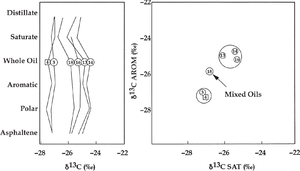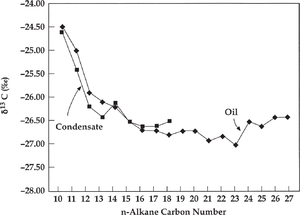Isotopic parameter data for oil–oil and oil–source rock correlations
| Exploring for Oil and Gas Traps | |

| |
| Series | Treatise in Petroleum Geology |
|---|---|
| Part | Critical elements of the petroleum system |
| Chapter | Oil–oil and oil–source rock correlations |
| Author | Douglas W. Waples, Joseph A. Curiale |
| Link | Web page |
| Store | AAPG Store |
Isotopic parameters are measurements of the ratio of one stable isotope to that of another stable isotope of the same element. Stable isotope ratios are usually measured on carbon but sometimes are measured on sulfur or hydrogen.
Carbon isotope ratios

Carbon isotope ratios are commonly measured on whole oils, kerogens, and whole extracts (bitumens) from rocks. In many cases they are also measured on the C15+ saturate and aromatic fractions and are often displayed on a Sofer.[2] diagram (e.g., the figure on the right, below). Less commonly, carbon isotope ratios are measured on the distillate and/or chromatographic fractions. For oil-source rock correlations, isotope ratios can also be measured on kerogen. Results of isotope analyses are often presented in a socalled Galimov diagram (left, below). Carbon isotope ratios can be characteristic of geologic age and environment.[3][4]
Figure 1 shows carbon isotope ratios for fractions of six oils comprising two families from the Zagros orogenic belt. The “Galimov” plot (left) and the Sofer diagram (right) show the δ13C values. Oils 3 and 4 are from the Ahwaz field, whereas oils 13, 14, and 16 are from the northeastern Dezful area. The midrange position of oil 18 suggests that it could be a mixture of these two main oil types. These conclusions are also supported by molecular and elemental data.
Compound-specific isotope analysis
Over the last decade, much interest has developed in compound-specific isotope analysis, in which carbon isotope ratios are measured for numerous individual compounds in a sample and then plotted to give a fingerprint.
In addition to n-alkanes, isotope ratios have been measured for pristane, phytane, and other biomarkers.[5][6] Although this technique is highly promising for correlations, initial attempts to interpret the data suggest that additional research to identify causes for isotopic variations will be necessary before the technique can be applied routinely and with confidence.
Figure 2 shows an example of a correlation between an oil and a condensate using δ13C values for individual C10 – C27 n-alkanes. These two samples are from a single oil field on the U.S. Gulf Coast. The condensate does not contain measurable n-alkanes beyond n-C18, rendering biomarker techniques of little value. The similarity in n-alkane δ13C values for these two samples supports the conclusion that they are sourced from similar organic facies.
Sulfur and hydrogen isotopes
Sulfur isotopes are frequently measured for high-sulfur oils and related kerogens. They are useful primarily in distinguishing among various types of anoxic environments.[7] Hydrogen isotopes are used occasionally, particularly for gases. Interpretation of hydrogen isotopes for oils is difficult.[8]
References
- ↑ Bordenave, M. L., and R. Burwood, 1990, Source rock distribution and maturation in the Zagros orogenic belt: provenance of the Asmari and Bangestan reservoir oil accumulations: Organic Geochemistry, vol. 16, p. 369–387., 10., 1016/0146-6380(90)90055-5
- ↑ Sofer, Z., 1984, Stable carbon isotope compositions of crude oils: application to source depositional environments and petroleum alteration: AAPG Bulletin, vol. 68, p. 31–49.
- ↑ Chung, H. M., M. A. Rooney, M. B. Toon, and G. E. Claypool, 1992, Carbon isotopic composition of marine crude oils: AAPG Bulletin, vol. 76, p. 1000–1007.
- ↑ Chung, H. M., M. A. Rooney, M. B., Toon, G. E. Claypool, M. A. Rooney, and R. M. Squires, 1994, Source characteristics of marine oils as indicated by carbon isotopic ratios of volatile hydrocarbons: AAPG Bulletin, vol. 78, p. 396–408.
- ↑ Bjorøy, M., K. Hall, P. Gillyon, and J. Jumeau, 1991, Carbon isotope variations in n-alkanes and isoprenoids of whole oils: Chemical Geology, vol. 93, p. 13–20., 10., 1016/0009-2541(91)90061-U
- ↑ Clayton, C. J., and M. Bjorøy, 1994, Effect of maturity on 13C/12C ratios of individual compounds in North Sea oils: Organic Geochemistry, vol. 21, p. 737–750., 10., 1016/0146-6380(94)90016-7
- ↑ Orr, W. L., 1986, Kerogen/asphaltene/sulfur relationships in sulfur-rich Monterey oils: Organic Geochemistry, vol. 10, p. 499–516., 10., 1016/0146-6380(86)90049-5
- ↑ Schoell, M., 1982, Application of isotopic analyses in oil and natural-gas research: Spectra, vol. 8, no. 2 & 3, p. 32–41.
